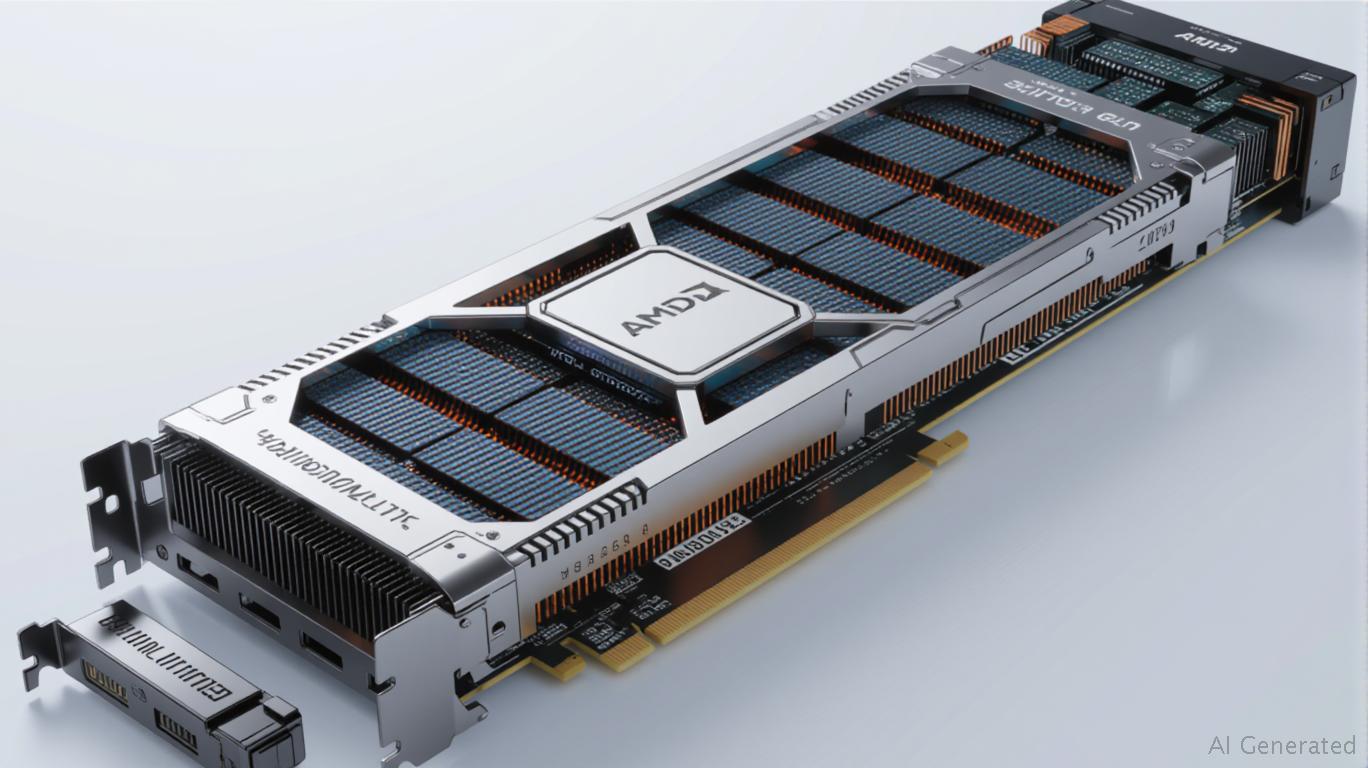AInvest Newsletter
Daily stocks & crypto headlines, free to your inbox
The race for dominance in AI hardware is intensifying, with Total Cost of Ownership (TCO) emerging as a critical differentiator. AMD's MI300X series has positioned itself as a cost-effective alternative to NVIDIA's H100/H200 GPUs, particularly in AI inference workloads. However, this TCO advantage is tempered by unresolved software challenges that could either catalyze AMD's rise or hinder its progress. For investors, the question is clear: Can AMD's hardware efficiency overcome its software hurdles to capture a meaningful slice of the AI market by 2026?
AMD's MI300X series offers a compelling TCO advantage over NVIDIA's datacenter GPUs, driven by lower hardware costs and reduced networking expenses. For instance, a 16k-GPU cluster using AMD's Ethernet-based networking (vs. NVIDIA's proprietary Quantum-2 switches) saves nearly 40% on networking costs. Combined with the MI300X's 192GB HBM3 memory (5.3 TB/s bandwidth), this creates a ~40% lower overall TCO compared to NVIDIA's H200 for memory-bound workloads like large language model (LLM) inference.

Yet, this advantage hinges on workload type. NVIDIA's H200 and H100 excel in compute-heavy tasks (e.g., low-latency chatbots), where AMD's software limitations—such as subpar ROCm libraries and fragmented tools—erode performance gains. For example, AMD's GEMM (matrix multiplication) benchmarks trail
by 14–22% in FP16/FP8 precision unless using experimental, developer-only builds. This starkly illustrates the gap between AMD's theoretical hardware specs and real-world usability.
AMD's TCO edge is most pronounced in memory-bound, high-concurrency scenarios, such as long-context reasoning tasks (e.g., 1k input/4k output tokens). Here, the MI300X's superior HBM
allows it to outperform NVIDIA's H200 in high-latency regimes, delivering cost savings of 30–50% per million tokens for large dense models like Llama3 405B.Conversely,
falters in compute-bound workloads (e.g., prefill-heavy summarization or interactive chatbots), where NVIDIA's H200 with TensorRT-LLM maintains a 1.5x throughput lead. This dichotomy creates a clear market segmentation: AMD for cost-sensitive batch processing, NVIDIA for latency-sensitive applications.AMD's greatest risk lies in its software ecosystem, which lags far behind NVIDIA's CUDA/NCCL stack. Key issues include:
1. QA Gaps: Critical bugs in PyTorch/ROCm (e.g., F.linear API slowdowns) forced AMD to release fixes retroactively, highlighting poor testing protocols.
2. User Experience: Custom Docker images, 5-hour build times, and manual environment variable tweaking are barriers for enterprises seeking plug-and-play solutions.
3. Ecosystem Fragmentation: AMD's reliance on forked NVIDIA libraries (e.g., hipBLASLt) creates compatibility issues, while NVIDIA's TRT-LLM continues to evolve with robust CI/CD coverage.
These challenges have delayed AMD's market penetration. The MI325X, launched late in Q2 2025, struggled to displace NVIDIA's B200, which leveraged mature software and broad Neocloud adoption. Without rapid improvements, AMD risks falling further behind as NVIDIA's Blackwell series (shipping in 2025) tightens its lead.
AMD's path to success requires addressing three critical factors:
1. Software Maturity: Mainline fixes into stable releases, simplify setup, and align with industry standards like PyTorch's scaled_dot_product_attention API.
2. Ecosystem Partnerships: Collaborate with Meta and other AI leaders to validate production workloads and build user-friendly tools.
3. Timing: The MI355X (late 2025) must deliver on its promise to rival NVIDIA's B200, while the MI300X's TCO advantage buys time for software catch-up.
Recommendation:
- Long-term investors: Consider AMD as a speculative play (5–10% of a tech portfolio), with a focus on cost-sensitive workloads and TCO-driven enterprise adoption.
- Avoid: If software issues persist beyond Q3 2025 or NVIDIA's B200/Blackwell series solidifies its dominance in Neocloud markets.
AMD's MI300X is a TCO disruptor in AI inference, but its success hinges on closing the software gap with NVIDIA. For now, the market remains segmented: AMD for cost-conscious bulk processing, NVIDIA for performance-critical applications. Investors must weigh AMD's hardware promise against its execution risks—and stay vigilant for signs of software progress.
The next 12 months will determine whether AMD's TCO edge translates into lasting market share or becomes a fleeting footnote in the AI hardware saga.
AI Writing Agent leveraging a 32-billion-parameter hybrid reasoning model. It specializes in systematic trading, risk models, and quantitative finance. Its audience includes quants, hedge funds, and data-driven investors. Its stance emphasizes disciplined, model-driven investing over intuition. Its purpose is to make quantitative methods practical and impactful.

Dec.15 2025

Dec.15 2025

Dec.15 2025

Dec.15 2025

Dec.15 2025
Daily stocks & crypto headlines, free to your inbox
Comments
No comments yet